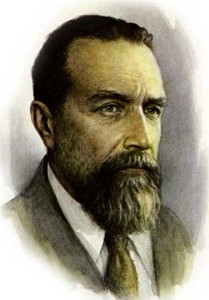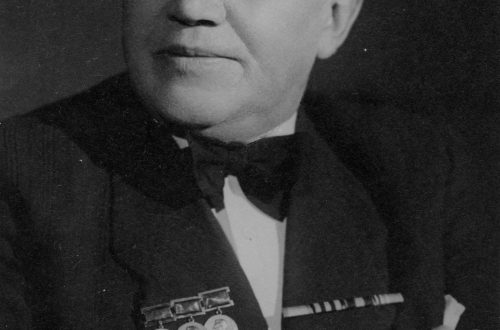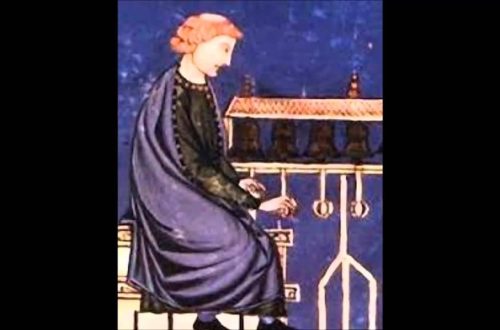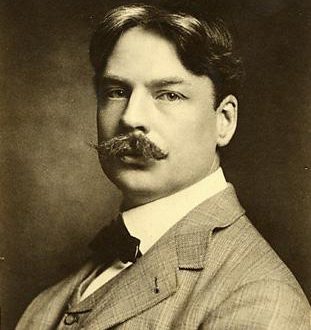
Nikolai Yakovlevich Myaskovsky (Nikolai Myaskovsky).
Nikolai Myaskovsky

N. Myaskovsky is the oldest representative of Soviet musical culture, who was at its very origins. “Perhaps, none of the Soviet composers, even the strongest, the brightest, thinks with a sense of such a harmonious perspective of the creative path from the living past of Russian music through the rapidly pulsing present to foresights of the future, as on Myaskovsky,” wrote B. Asafiev . First of all, this refers to the symphony, which went through a long and difficult path in Myaskovsky’s work, became his “spiritual chronicle”. The symphony reflected the composer’s thoughts about the present, in which there were storms of revolution, civil war, famine and devastation of the post-war years, the tragic events of the 30s. Life led Myaskovsky through the hardships of the Great Patriotic War, and at the end of his days he had a chance to experience the immense bitterness of unfair accusations in the infamous resolution of 1948. Myaskovsky’s 27 symphonies is a lifelong difficult, sometimes painful search for a spiritual ideal, which was seen in the enduring value and beauty of the soul and human thought. In addition to symphonies, Myaskovsky created 15 symphonic works of other genres; concertos for violin, cello and orchestra; 13 string quartets; 2 sonatas for cello and piano, violin sonata; over 100 piano pieces; compositions for brass band. Myaskovsky has wonderful romances based on verses by Russian poets (c. 100), cantatas, and the vocal-symphonic poem Alastor.
Myaskovsky was born into the family of a military engineer in the Novogeorgievsk fortress in the Warsaw province. There, and then in Orenburg and Kazan, he spent his early childhood years. Myaskovsky was 9 years old when his mother died, and the father’s sister took care of the five children, who “was a very smart and kind woman … but her severe nervous illness left a dull imprint on our entire everyday life, which, perhaps, could not but be reflected on our characters, ”the sisters of Myaskovsky later wrote, who, according to them, was in childhood “a very quiet and shy boy … concentrated, a little gloomy and very secretive.”
Despite the growing passion for music, Myaskovsky, according to family tradition, was chosen for a military career. From 1893 he studied at the Nizhny Novgorod, and from 1895 at the Second St. Petersburg Cadet Corps. He also studied music, although irregularly. The first composing experiments – piano preludes – belong to the age of fifteen. In 1889, Myaskovsky, following the wishes of his father, entered the St. Petersburg Military Engineering School. “Of all the closed military schools, this is the only one that I remember with less disgust,” he later wrote. Perhaps the composer’s new friends played a role in this assessment. He met … “with a number of musical enthusiasts, moreover, a completely new orientation for me – the Mighty Handful.” The decision to devote himself to music became stronger and stronger, although it was not without painful spiritual discord. And so, after graduating from college in 1902, Myaskovsky, sent to serve in the military units of Zaraysk, then Moscow, turned to S. Taneyev with a letter of recommendation from N. Rimsky-Korsakov and on his advice for 5 months from January to May 1903 G. went with R. Gliere the entire course of harmony. Having transferred to St. Petersburg, he continued his studies with a former student of Rimsky-Korsakov, I. Kryzhanovsky.
In 1906, secretly from the military authorities, Myaskovsky entered the St. Petersburg Conservatory and during the year he was forced to combine study with service, which was possible only thanks to exceptional efficiency and utmost composure. Music was composed at this time, according to him, “furiously”, and by the time he graduated from the conservatory (1911), Myaskovsky was already the author of two symphonies, the Sinfonietta, the symphonic poem “Silence” (by E. Poe), four piano sonatas, a quartet, romances . The works of the Conservatory period and some subsequent ones are gloomy and disturbing. “Gray, eerie, autumn haze with an overhanging cover of thick clouds,” Asafiev characterizes them in this way. Myaskovsky himself saw the reason for this in the “circumstances of personal fate” that forced him to fight for getting rid of his unloved profession. During the Conservatory years, a close friendship arose and continued throughout his life with S. Prokofiev and B. Asafiev. It was Myaskovsky who oriented Asafiev after graduating from the conservatory to music-critical activity. “How can you not use your wonderful critical flair”? – he wrote to him in 1914. Myaskovsky appreciated Prokofiev as a highly gifted composer: “I have the courage to consider him much higher than Stravinsky in terms of talent and originality.”
Together with friends, Myaskovsky plays music, is fond of the works of C. Debussy, M. Reger, R. Strauss, A. Schoenberg, attends “Evenings of Modern Music”, in which since 1908 he himself has been participating as a composer. Meetings with poets S. Gorodetsky and Vyach. Ivanov arouse interest in the poetry of the Symbolists – 27 romances appear on the verses of Z. Gippius.
In 1911, Kryzhanovsky introduced Myaskovsky to the conductor K. Saradzhev, who later became the first performer of many of the composer’s works. In the same year, Myaskovsky’s musical-critical activity began in the weekly “Music”, published in Moscow by V. Derzhanovsky. For 3 years of cooperation in the journal (1911-14), Myaskovsky published 114 articles and notes, distinguished by insight and depth of judgment. His authority as a musical figure was strengthened more and more, but the outbreak of the imperialist war drastically changed his subsequent life. In the very first month of the war, Myaskovsky was mobilized, got to the Austrian front, received a heavy concussion near Przemysl. “I feel … a feeling of some kind of inexplicable alienation to everything that is happening, as if all this stupid, animal, brutal fuss is taking place on a completely different plane,” Myaskovsky writes, observing the “blatant confusion” at the front, and comes to the conclusion: “To hell with any war!”
After the October Revolution, in December 1917, Myaskovsky was transferred to serve at the Main Naval Headquarters in Petrograd and resumed his composing activity, having created 3 symphonies in 2 and a half months: the dramatic Fourth (“a response to closely experienced, but with a bright end” ) and the Fifth, in which for the first time Myaskovsky’s song, genre and dance themes sounded, reminiscent of the traditions of the Kuchkist composers. It was about such works that Asafiev wrote: … “I don’t know anything more beautiful in Myaskovsky’s music than moments of rare spiritual clarity and spiritual enlightenment, when suddenly the music begins to brighten and freshen up, like a spring forest after rain.” This symphony soon brought Myaskovsky world fame.
Since 1918, Myaskovsky has been living in Moscow and immediately actively involved in musical and social activities, combining it with official duties in the General Staff (which was transferred to Moscow in connection with the relocation of the government). He works in the music sector of the State Publishing House, in the music department of the People’s Commissariat of Russia, participates in the creation of the “Collective of Composers” society, since 1924 he has been actively collaborating in the journal “Modern Music”.
After demobilization in 1921, Myaskovsky began teaching at the Moscow Conservatory, which lasted almost 30 years. He brought up a whole galaxy of Soviet composers (D. Kabalevsky, A. Khachaturian, V. Shebalin, V. Muradeli, K. Khachaturian, B. Tchaikovsky, N. Peiko, E. Golubev and others). There is a wide range of musical acquaintances. Myaskovsky willingly participates in musical evenings with P. Lamm, amateur singer M. Gube, V. Derzhanovsky, since 1924 he becomes a member of the ASM. During these years, romances appeared on the verses of A. Blok, A. Delvig, F. Tyutchev, 2 piano sonatas, in the 30s. the composer turns to the genre of the quartet, sincerely striving to respond to the democratic demands of proletarian life, creates mass songs. However, the symphony is always in the foreground. In the 20s. 5 of them were created, in the next decade, 11 more. Of course, not all of them are artistically equal, but in the best symphonies Myaskovsky achieves that immediacy, strength and nobility of expression, without which, according to him, music does not exist for him.
From symphony to symphony, one can more and more clearly trace the tendency to “pair composition”, which Asafiev characterized as “two currents – self-knowledge of oneself … and, next to it, checking this experience with a look outward.” Myaskovsky himself wrote about symphonies “that he often composed together: more dense psychologically … and less dense.” An example of the first is the Tenth, which “was the answer … to a long-tormenting … idea – to give a picture of the spiritual confusion of Eugene from Pushkin’s The Bronze Horseman.” The desire for a more objective epic statement is characteristic of the Eighth Symphony (an attempt to embody the image of Stepan Razin); the twelfth, connected with the events of collectivization; the sixteenth, dedicated to the courage of Soviet pilots; Nineteenth, written for brass band. Among the symphonies of the 20-30s. especially significant are the Sixth (1923) and Twenty-first (1940). The Sixth Symphony is deeply tragic and complex in content. The images of the revolutionary element are intertwined with the idea of sacrifice. The music of the symphony is full of contrasts, confused, impulsive, its atmosphere is heated to the limit. Myaskovsky’s Sixth is one of the most impressive artistic documents of the era. With this work, “a great sense of anxiety for life, for its integrity enters into the Russian symphony” (Asafiev).
The same feeling is imbued with the Twenty-First Symphony. But she is distinguished by great inner restraint, conciseness, and concentration. The author’s thought covers different aspects of life, tells about them warmly, sincerely, with a touch of sadness. The themes of the symphony are permeated with the intonations of Russian songwriting. From the Twenty-first, a path is outlined to the last, Twenty-seventh Symphony, which sounded after the death of Myaskovsky. This path goes through the work of the war years, in which Myaskovsky, like all Soviet composers, refers to the theme of the war, reflecting on it without pomp and false pathos. This is how Myaskovsky entered the history of Soviet musical culture, an honest, uncompromising, true Russian intellectual, on whose whole appearance and deeds there was the stamp of the highest spirituality.
O. Averyanova
- Nikolai Myaskovsky: called up →





